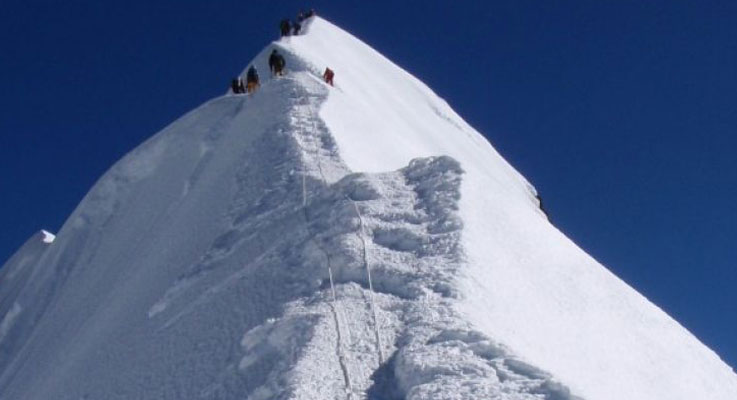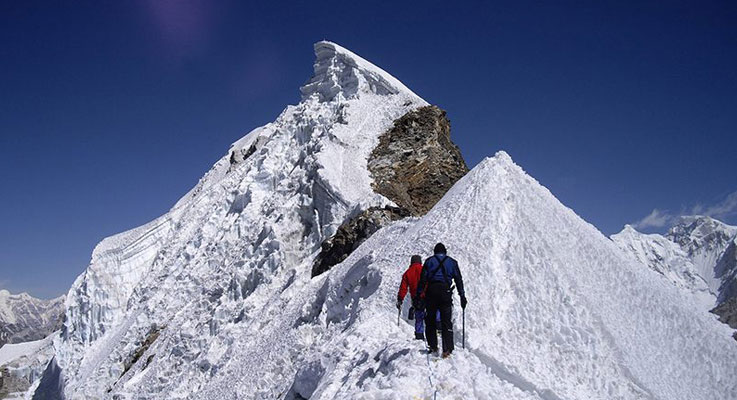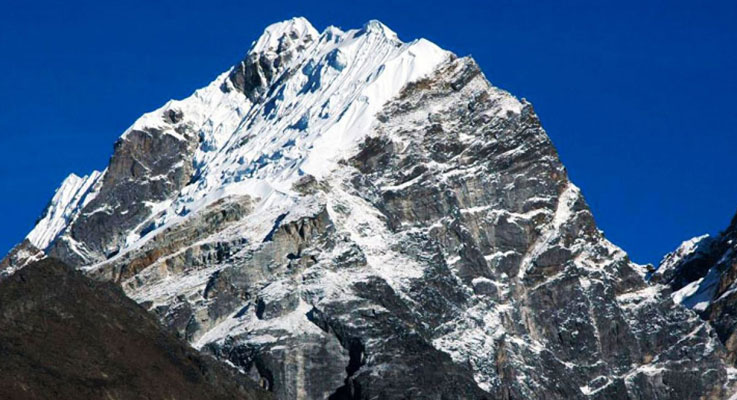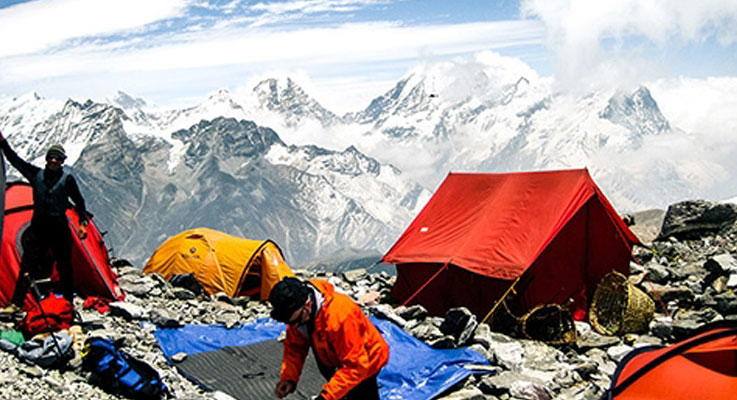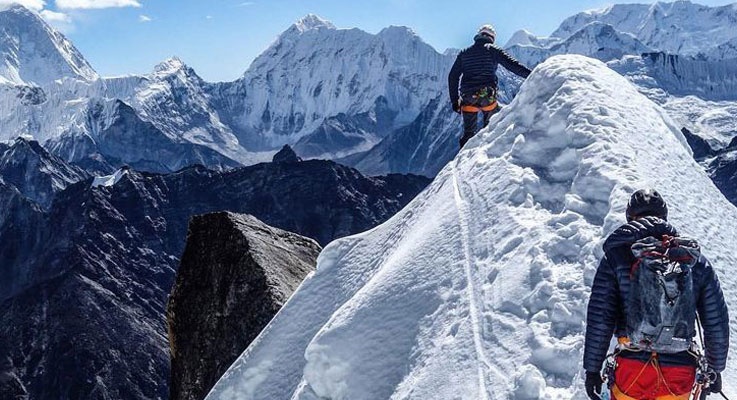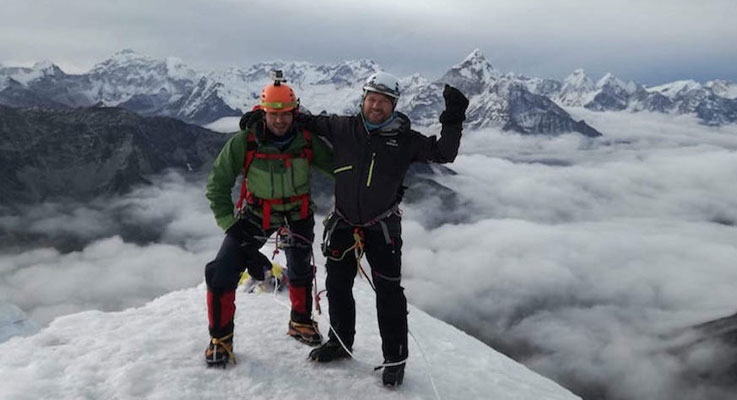-
Day 1
Arrival in Kathmandu (1,345m/4,413 ft)
Upon arriving at Tribhuwan International Airport in Kathmandu, you will be received by our airport representatives who will warmly greet you and transfer to the hotel on a private tourist vehicle. We provide 3-star accommodation in the city and we arrange for a trip briefing with dinner in the evening.
-
Day 2
Visit old town of Kathmandu
A professional guide and vehicle are provided for a day of sightseeing in and around Kathmandu city. We visit some of the UNESCO World Heritage Sites in the city along with other interesting cultural monuments that dot the valley. These include Boudhanath Stupa (the largest Buddhist shrines in the world), Pashupatinath (the holiest Hindu temple in the world), Durbar Squares (Palaces and fortresses of medieval Kings), along with other popular cultural attractions. We get to observe the lifestyle of Nepalese people, holy sadhus and monks, fascinating history as well as awe-inspiring architecture.
-
Day 3
Fly from Kathmandu to Lukla (2,800m/9,186 ft). Trek to Phakding (2,610m/8,563 ft)
Early in the morning, you will be transferred to the airport in Kathmandu for a scenic 30-minute flight to Lukla. The airport guide will brief you and introduce our porters before we begin our trek towards Phakding (2,610m). There will be some time to explore the village while our Sherpa crew sorts and loads trekking equipment and baggage. The trek starts with a descent to DudhKosi River, from where the wider trail leads us to the village of Ghat (2,550m), and then to Phakding on an easy-paced walk.
-
Day 4
Trek from Phakding to Namche Bazar (3,440m/11,286 ft)
Walking along the shores of DudhKosi, we get to cross the serene river many times on exhilarating suspension bridges decorated with prayer flags. A little further, we enter Sagarmatha National Park from where the trail climbs steeply with picturesque sights. After trekking for a few hours, we reach Namche Bazaar, known as the Gateway of Everest.
-
Day 5
Namche Bazaar acclimatization day
In order to acclimatize to the altitude gained and thinner air, we spend a day in Namche Bazaar. There are several quality restaurants, hotels, lodges, shops, money exchange services, internet cafes and bakeries at this town, also the largest in the Everest region. We pay a visit to the museum nearby known for its traditional artefacts that showcase the Sherpa culture. We also hike to Syangboche Airport from where we can see rewarding vistas of stunning sunrise and sunset over the Himalayan panorama.
-
Day 6
Trek from Namche Bazaar to Deboche (3,800m / 12,467ft)
We ascend out of the village and follow a high, fairly level path above the DudhKosi enjoying spectacular mountain views of Everest, Nuptse and Lhotse as we go. We pass the various shops set up by Tibetans selling trinkets and then descend through forest of blue pine to cross the DudhKosi again at Phunki (3,250m). We make another ascent on a switchback trail, sometimes made quite dusty by yak trains, to reach the spectacularly sited Thyangboche Monastery (3,867m) from where there are brilliant views of Everest, Lhotse, Nuptse, AmaDablam and Taboche to the north and northeast, Thamserku and Kantega to the southeast and Kwangde to the southwest. Thyangboche Monastery was seriously damaged by fire in 1989 but has since been rebuilt and there will be time to visit both the monasteries and a museum. We reach our teahouse at Deboche. 6 hours walk.
-
Day 7
Trek from Deboche to Orsho (4,130m / 13,550ft)
Descend through meadows and Rhododendron forest, past the Buddhist nunnery at Deboche to cross ImjaKhola (river) and up to pass village of Pangboche. Now above the tree line, climb up to the Orsho (4,100m). Approx 4.5 hrs walk mostly ascending. 120m descent 340m ascent.
-
Day 8
Trek from Orsho to Dingboche (4,350m/14,272 ft)
Gradually climb up hill to the confluence of the Khumbu and ImjaKhola we continue to Dingboche (4410m). Approx 2.5 hrs walk. 310m ascent. Afternoon optional walk to Chukhung 4730m (5 hours) or to Nangkartshang peak 5,060m (5 hours).
-
Day 9
Trek from Dingboche to Lobuche (4,910m/16,109 ft)
Walk to Dughla (4620m) and ascend to Lobuche at 4930 m. (Approx 6 hours walk) 580m ascent 60 descent.
-
Day 10
Trek from Lobuche to EBC (5,365m/17,602 ft) and then to Gorakshep (5,180m/16,995 ft)
Early start for the excursion to Base Camp. Gentle walk initially, then ascend after about an hour and cross the moraine. Descend to the expanse of the Gorakshep (5,150m), where we check in the Lodge. From GorakShep, the trail splits off to Base Camp and Kalapathar. There is a possibility of meeting/visiting famous climbers and their camps at Everest Base Camp. Retrace steps to Gorakshep. About 9 hours walk ascent 560m and descent 106m)
-
Day 11
Trek from GorakShepto Kala Patthar (5545 m/18,192 ft), back toLobuche (4940 m/16,207 ft)
Today is the climax of our trip. We start early in the morning to catch the dramatic views from Kala Patthar witnessing the first light of day shining on Mount Everest. However, we need to get prepared for an early morning, dark and cold temperature (-10 to -14 C) departure beforehand. Plus there is always the potential for chilly winds which are quite common. Familiar peaks such as Lingtren, Khumbutse, Changtse tower to the east even as Everest begins to reveal itself emerging between the west shoulder crest and Nuptse. During the ascent to Kala Patthar we can pause to catch our breath at several outstanding view points to snap pictures. After several hours of an ascent, we reach Kala Patthar. From here we scramble to climb the rocky outcrop near to the summit marked by cairns and prayer flags. As we reach the top, we sit on the Kala Patthar rocks our eyes taking in the unbelievable Himalayan Panorama, wandering from one mighty massif to another. We take as many pictures as we can with our camera and take the in view with our mind's eye to last lifetime. On being back to GorakShep, we have breakfast followed by a gradual descend down to Lobuche for a good night's rest.
-
Day 12
Trek from Lobuche to Lobuche Base Camp (4,865m/15,957 ft)
Today, we begin our trek from Lobuche toward the Lobuche Base Camp. After walking some distance on relatively flatter plane, the path to the Lobuche Base Camp gets steeper and rocky. Since, we will be trekking toward somewhat lower altitude today, you may it find it easier for your body. Move forward along the Lobuche Glacier, while enjoying the great views of AmaDablam, Cholatse, Pokalde, Thamserku, Kantega, etc. After reaching the Lobuche Base Camp, take rest for some time and make necessary preparation for the summit. After lunch, our guides will provide training on peak climbing techniques and using climbing gears such as ice axe, climbing boot, harness, jummer, and how to go up and down using ropes. There will be training on how to fix the ropes, climbing technique, and about the knot and gears. Some training experience would certainly boost up your confidence and climbing skills thus increasing the chances of scaling the summit as well as fully enjoy the experience.
-
Day 13
Trek from Lobuche Base Camp to Lobuche High Camp (5,600m/18,368 ft)
Today, after breakfast we make a hike from Lobuche Base Camp to the Lobuche High Camp. The climb takes for about 4 hours. The High camp is located at 5,600m/18,368 ft. From Base Camp, we hike on a rocky moraine path to reach the high camp. Upon reaching the high camp, we set up our camp, take lunch and rest. You can also walk around for some time that would also help in acclimatization.
-
Day 14
Summit Day: Lobuche Peak (6,145m) Summit & back to Base Camp
Today is our cherished day for the summit. We start early in the morning for the summit endeavour. Lobuche east offers more panoramic views of the mountains that other popular peaks such as Island Peak. Once upon the Lobuche summit, you would enjoy magnifiscently panoramic views of Everest, Lhotse, Nuptse, AmaDablam, Cholatse, Pumori, and many more. We spend some time at the summit celebrating and taking pictures, then we get back to the High Camp again.
-
Day 15
Reserve Day for Contingency
There is no such guarantee that we can get quite a favorable weather on our planned day for the summit, so this day is used as a contingency in case if we are unable to summit the Lobuche Peak on day 14 due to bad weather condition or some other reasons. If weather gets exceptionally unfavorable we wisely have to postpone the program of summit the peak on day 14 for toady (Day 15). Sometimes somebody in the group may get some problems in acclimatizing well enough to make the ascent; the day can be used in that condition too. If the trip goes smoothly, we do not need this spare day.
-
Day 16
Trek from Lobuche Base Camp to Pangobche (3930 m / 12900 ft)
After taking our morning breakfast, we trek downhill from Lobuche Base Camp and join the Everest Base Camp route at Lobuche again. We take our lunch at Lobuche. From Lobuche we again retrace our path to Pheriche. On the way to Pheriche, enjoy the magnificent views of Mt. Amadablam in the distance. From Pheriche, we continue to Pangboche. Some of the other peaks that you would enjoy include Pokalde, Thamserku, Kantega among others. We will trek down through the hillside blanketed by rhododendron and juniper trees. If it's spring, pink and red rhododendron flowers ablaze our surroundings. Upon reaching Pangboche you may also consider visiting the famous Pangoche Monastery.
-
Day 17
Trek from Pangboche to NamcheBazzar (3,440 m/11,280 ft)
After crossing the prayer flag festooned bridge over the DudhKoshi River trail then follows the DudhKoshi gorge descending rapidly through the pine forests. The path eventually reaches Sansa which is the major trail junction in the region. We unknowingly appreciate the gorgeous AmaDablam, Thamserku and Nuptse with every bite. Following lunch, the trail to Namche Bazaar clings to the steep wooded slope beyond Kyangjuma, winding through several bends. We keep a lookout for wild life such as mountain goats, snow leopards, colorful pheasants, etc., while we pass through the forest by the trail. After passing a Chorten, we reach the army camp at of Namche Bazaar. We want to take a long last look (and picture!) back to Lhotse, the tip of Everest and Tengboche from here. On reaching our lodge, we take a nice hot shower and have very relaxed sleep in our room in Namche Bazaar.
-
Day 18
Trek from Namche Bazaar to Lukla (2,800m/9,186ft)
The trail descends steeply downward so we need to walk slowly and under control as our shaky legs continuously battle the rocky terrain. After crossing the suspension bridges over the fast flowing DudhKoshi and its tributaries the trail becomes more level and natural
-
Day 19
Fly from Lukla to Kathmandu (1,345m/4,413 ft)
Today we fly back to Kathmandu from Lukla, and during your flight you can enjoy some last-minute glimpses of the mountains. Upon arrival in Kathmandu, you can rest, relax and go sightseeing throughout the day.
-
Day 20
Leisure day in Kathmandu
Today will be leisure and rest day. You are free to go souvenir shopping, spa and more exploration of the city, or extend your trip to include bungee jumping, rafting, mountain biking, Everest mountain flight and other adventurous activities. In the evening, we will have a farewell dinner at MulChowk Restaurant’s cozy and elegant dining ambience.
-
Day 21
Departure from Nepal
The trip concludes today. You will be dropped at Kathmandu's Tribhuwan International Airport by our airport representative for your flight departure from Nepal.

